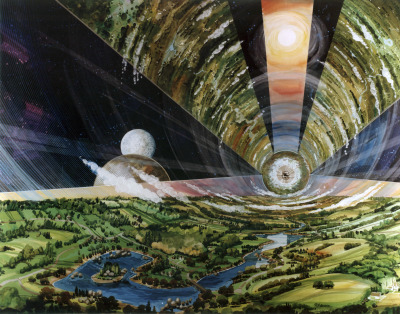SHOULD WE BUILD COLONIES IN SPACE BEFORE MARS?
/
Image from http://spacecolonization.wikia.com/wiki/O'Neill_Cylinder
Recent data sent by NASA’s MAVEN spacecraft is bad news for those who hope to someday open up Mars for human colonization.
We already knew that the Martian atmosphere is very thin (about 1% as dense as Earth’s at sea level). To make the Red Planet suitable for humans to live on we’ll have to drastically thicken the air and also heat it up. There were hopes that carbon dioxide, a greenhouse gas, could be freed from the soil and ice caps of Mars to produce a good atmosphere for trapping heat and feeding plants, which would then produce oxygen. It had been thought that much of Mars’ lost atmosphere had been absorbed into the soil, but the new MAVEN data (short for Mars Atmosphere and Volatile Evolution) suggests that most of that ancient atmosphere vanished into space, stripped away by the solar wind and solar explosions after Mars’ magnetic field died about four billion years ago. It’s gone and can’t be retrieved. That might not affect plans to build domed or underground cities on Mars, but terraforming the whole planet will be a lot harder.
Terraforming Mars was never a short-term project anyway, and the biggest drawbacks to colonies there include gravity and distance. We still don’t know if regular exercise and other methods will mitigate the potential health problems of living in a low gravity environment. And trying to build up the population of Martian colonies will require a lot of very long trips—about nine months one-way as technology stands, but that’s when Earth and Mars are in the right alignment, which only happens every couple of years. That’s a slow process. If our goals are to protect a sampling of the human race from potential disasters on Earth, ease population pressures on Earth, and make use of resources and manufacturing advantages that space provides, we’ll want something quicker.
If we build manufacturing complexes on the Moon, we can make the materials and air to build free-floating colonies in space, possibly in orbit around Earth or the Moon, but more likely where the gravity of the two bodies balances out at the so-called Lagrange points. That doesn’t mean that colonists would live in zero gravity (although they could get to it when they wanted to do a little recreational flying perhaps). One of the popular concepts is a gigantic rotating space wheel like in the movie Elysium that would produce artificial gravity on its inner surface from its rotation. The best-known example is called a Stanford Torus. But my preference would be a miles-long cylinder that would produce a gravity effect by spinning along its long axis. Its inner surface would alternate bands of habitable space with long windows to let in sunlight. In the 1970’s Gerard O’Neill proposed cylinders 32 kilometers long that would provide almost 1300 square kilometers of living space for several million people. Maybe my preference has to do with my love for the Arthur C. Clarke classic Rendezvous With Rama.
These colonies would avoid the concerns about low gravity and be close—only a few days travel from Earth. Research funded by NASA in the ’70’s said that such things could be built with the technology of the time, but materials, knowledge, and tech developed since then would make the job even more feasible.
So while I’m all in favour of Mars exploration for the sake of knowledge, I think the human race would be better served by focusing our colonization plans on free-floating near-Earth colonies or the Moon for the near future. If you think I’m off-base, let me know. Maybe you just have more patience than I do.
The good news this past week? NASA will accept applications from Dec. 14, 2015 through mid-February 2016 for their next class of astronaut candidates. Applications will be accepted at:
http://www.usajobs.gov . It’s only for U.S. citizens (unfortunately) but you could end up working on the International Space Station, a couple of spacecraft being produced by commercial companies, or even NASA’s Orion deep-space exploration vehicle.
The final frontier…but you know all that.

